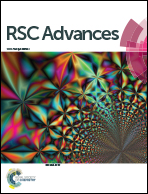PCN-222@g-C3N4 cathodic materials for “signal-off” photoelectrochemical sensing of kanamycin sulfate†
Abstract
A novel cathodic photoelectrochemical (PEC) sensor was developed for the ultrasensitive detection of kanamycin sulfate (KAM) based on the g-C3N4 coupled zirconium-based porphyrinic metal–organic framework (PCN-222). Photocathodes made by double n-type semiconductors, which was attributed to the transfer of electrons and holes from g-C3N4 broad band to PCN-222 with narrow band gap. The photocurrent decreased when KAM was added, which was conducive to the construction of the PEC sensor. Then, the PCN-222@g-C3N4 was used as a photosensitive platform to construct a label-free strategy and ultrasensitive detection of KAM with wide linear range from 1 to 1000 nM and a low detection limit of 0.127 nM. Moreover, this sensing platform shows good selectivity, favourable reproducibility and brilliant stability. The reported sensors provided great potential for the detection of KAM in actual samples.



 Please wait while we load your content...
Please wait while we load your content...